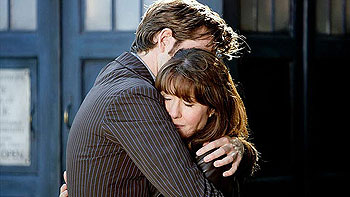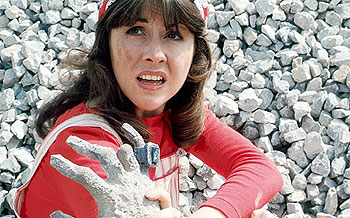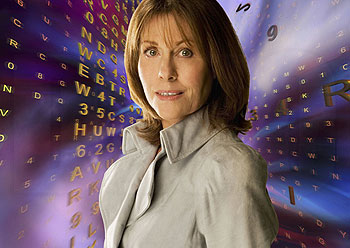Doctor Who‘s Elisabeth Sladen: An Appreciation
Published on May 30th, 2011 in: Climb Onto The Nearest Star, Eulogy, Feminism, Issues, Science Fiction, TV, Underground/Cult |By Cait Brennan

As Doctor Who fans prepared to celebrate the launch of its most anticipated series yet, the show lost one of its most enduring stars. Elisabeth Sladen, who portrayed Sarah Jane Smith, died April 19, leaving behind generations of fans and a legacy as one of the most popular characters in science fiction history.
That’s a lot of “mosts” but it’s difficult to overstate Sladen’s importance to Doctor Who. During her time in the TARDIS, the show grew from an almost exclusively British phenomenon to a global cult hit. Aided by countless public television airings in the United States, Tom Baker’s Doctor and Sladen’s Sarah Jane Smith became some of the most recognizable science fiction icons of the 1970s, and helped set the stage for the show’s current international success.
While her years as a regular cast member in the classic series ended an astonishing 35 years ago, her popularity never ebbed. Sladen spent the better part of the last four decades as an unofficial ambassador for the series and one of its busiest stars. She continued the role in an astonishing array of official and unofficial spin-off media, from audio dramas and one-off television specials, to a starring role in a long-running show of her own, The Sarah Jane Adventures. At her peak, Sladen’s Sarah Jane was a powerhouse to rival even the most popular Doctors in the show’s history.
Her debut was less auspicious. Sarah Jane first appeared in 1973’s “The Time Warrior” as an investigative journalist sneaking into a top-secret installation in order to get the scoop on strange disappearances. Jon Pertwee’s Doctor, a tattooed space-Aikido-chopping man’s man in a ruffly shirt, immediately tells her to “make herself useful” by getting him a pot of coffee. She promptly tells him off. While the tongue-in-cheek nature of this scene was plainly evident even in 1974 (and doubtless provided some chuckles in the writers’ room), Sarah Jane’s feminist-informed determination and resourcefulness would get the better of the Doctor’s occasionally-retrograde arrogance over the next several seasons.
As Pertwee’s Doctor was the first to discover, Sladen’s unique combination of confidence and vulnerability made her charm tough to resist. Whether facing off against the Loch Ness Monster, gigantic heartbroken robots, hunchbacked anti-matter men, giant radioactive spiders, potato-headed warriors, or the ever-persistent Daleks, Sarah Jane balanced girl-power toughness with wide-eyed wonder (as well as the requisite damsel-in-distress screams here and there).

She left the series at the peak of her popularity, in 1976’s “The Hand Of Fear.” Sarah Jane finds herself under the control of a fossilized hand she found in a quarry. The hand creates (and absorbs) a nuclear meltdown, regenerates into an awesome rock woman, then changes gender and becomes a deranged male megalomaniac bent on galactic conquest. Just another day at the office. (“I quite liked her, but I couldn’t stand him,” Sarah opines.) It’s Sarah Jane at her finest. If there’s a more memorable line in the series than Sladen’s delirious “Eldrad MUST live!” I haven’t heard it.
In contrast to the revived series’ romantically conflicted, emotional Doctors, the “classic” series played the Doctor as alien and emotionally remote; while he could be playful, funny, and compassionate, he could definitely not express physical affection with his companions, let alone love, lest moralists like Mary Whitehouse accuse the BBC of running some sort of trans-galactic den of interspecies chrono-erotic iniquity. Thus, when Sarah Jane chose to leave the Doctor at the end of “The Hand Of Fear,” their abrupt and sad goodbye—fraught with sublimated sentiment and unresolved tension though it may have been—did not even amount to a handshake.
Sladen’s departure from the series did not end her involvement with Doctor Who. Producer John Nathan-Turner soon tried to entice the star back to the series as a companion, but she declined, wanting new challenges. In 1981 she starred in a Sarah Jane spin-off pilot—the first Doctor Who spin-off ever, though given Sladen’s enduring popularity one can’t help but think some residual BBC sexism might have been at play when the show was entitled K-9 and Company.
Not only did Sarah Jane lose top billing to a tin dog, she lost it to “Company” as well, and the company did not in fact exist. Although the pilot did not lead to a full series, it’s charming in a good natured, youth-focused way (by British standards, anyway; a cheerful children’s show involving Satanic ritual human sacrifice did not appear in America until the debut of Barney and Friends in 1992.)
After years of voicing the character in radio dramas and audio plays, her full-fledged return to Doctor Who came in 2006, when Sarah Jane met David Tennant’s Tenth Doctor. While the new series has always been a direct continuation of the classic series (rather than a typical “reboot” or “reimagining”), it wasn’t until “School Reunion” that the promise of that premise was brought home.

Freed from the constraints of 1970s storytelling, Sarah Jane and the Doctor confronted their history in a moving story of love, mortality, and loss. The sheer strength of Sladen’s performance led to a proper spin-off, this time with the focus on Sarah Jane and not any nearby appliances. The Sarah Jane Adventures debuted in 2007, interweaving references, elements, and characters from Doctor Who‘s broader history in a way that the rebooted show didn’t dare. At the time of her death, Sladen was in production on a fifth series of her namesake series.
Sladen’s Sarah is often credited with bringing a feminist bent to the show, but from the outset, Doctor Who was often very progressive. Many of the Doctor’s female companions were quite accomplished: Zoe Heriot was an astrophysicist and mathematician; Jo Grant was a UNIT research scientist and later an ecologist; and Liz Shaw was a Cambridge-educated Doctor herself with degrees in both medicine and physics, among others. While all these brilliant ladies found themselves in Penelope Pitstop territory from time to time, feminism was not in grave peril before Sarah Jane arrived. And while those former companions are still adored by fans who grew up with them, Sladen transcended her era by bringing a warmth, vulnerability, and depth of characterization to Sarah Jane, imbuing her scenes with unspoken emotion.
In an era when so much of the obvious emotional underpinnings of the relationship between the Doctor and his companions could not even be hinted at, Sladen made it real by playing the unwritten notes in that song. She was the leading lady of a rich universe that will miss her dearly.
Time limit is exhausted. Please reload the CAPTCHA.